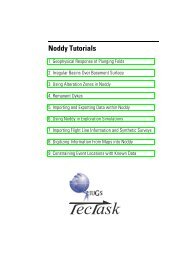Revised Eburnean geodynamic evolution of the ... - Tectonique.net
Revised Eburnean geodynamic evolution of the ... - Tectonique.net
Revised Eburnean geodynamic evolution of the ... - Tectonique.net
Create successful ePaper yourself
Turn your PDF publications into a flip-book with our unique Google optimized e-Paper software.
4.5. Forward modelling<br />
Forward-modelled geological cross-sections (Fig. 16) across<br />
<strong>the</strong> Ashanti Belt and Tarkwa Basin were constructed in order<br />
to understand and illustrate <strong>the</strong> structural relationship between<br />
<strong>the</strong> Birimian and Tarkwaian units produced during D1 and D3<br />
shortening events. These sections are geologically consistent with<br />
<strong>the</strong> regional interpretation and <strong>the</strong> field observations. Forwardmodelling<br />
was performed to ensure that geological cross-sections<br />
were also geophysically consistent with aeromag<strong>net</strong>ic, gravity and<br />
petrophysical data. Not all features within <strong>the</strong>se models produce<br />
a perceptible geophysical contrast but are o<strong>the</strong>rwise in agreement<br />
with <strong>the</strong> geological observations made within <strong>the</strong> study<br />
area.<br />
Modelling was performed using Oasis Montaj GM-SYS s<strong>of</strong>tware<br />
that utilises <strong>the</strong> algorithm <strong>of</strong> Talwani et al. (1959) and<br />
S. Perrouty et al. / Precambrian Research 204– 205 (2012) 12– 39 29<br />
Fig. 10. (Continued)<br />
Talwani and Heirtzler (1964) to calculate <strong>the</strong> gravity and mag<strong>net</strong>ic<br />
response <strong>of</strong> two-dimensional polygons. Construction <strong>of</strong> <strong>the</strong>se<br />
integrated geological and geophysical models involved creating<br />
a traditional geological cross-section that was assigned values <strong>of</strong><br />
mag<strong>net</strong>ic susceptibility and density. The different fold trends in<br />
<strong>the</strong> Birimian and Tarkwaian units are represented in 2D by different<br />
fold wavelengths, amplitudes and positions <strong>of</strong> fold axes as<br />
<strong>the</strong>y occur in <strong>the</strong> plane <strong>of</strong> <strong>the</strong> section. The geophysical response<br />
<strong>of</strong> this model was <strong>the</strong>n calculated and compared to <strong>the</strong> observed<br />
aeromag<strong>net</strong>ic and gravity anomalies. The geometry and mag<strong>net</strong>ic<br />
susceptibility/density values assigned to each rock package were<br />
<strong>the</strong>n manipulated within geologically reasonable limits to improve<br />
<strong>the</strong> agreement between <strong>the</strong> model response and <strong>the</strong> observed<br />
response.<br />
Mag<strong>net</strong>ic susceptibility ranges for <strong>the</strong> modelled rock packages<br />
were based on field and laboratory susceptibility measurements





